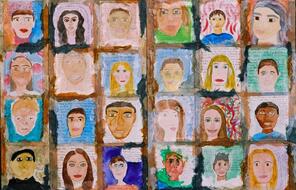The global Jewish community is diverse and broad: Judaism has been around for millennia and there are Jews living all over the world, who have different heritages, identities, skin colour, and professions, as well as different relationships to religion. In the present day, Jewish identity is about more than Judaism as a religion – someone might identify as Jewish because of their nationality, ethnicity, cultural heritage and/or religion.
Yet despite their diversity, Jews have been discriminated against, ostracised and attacked for millennia just for being Jewish. This hatred of and hositility towards Jews, which in the present day is known as antisemitism, has evolved over time as new generations have adapted anti-Judaic ideologies to retain relevance in the face of shifting world views, anxieties and social customs.
At its root, antisemitism relies on the idea that certain physical, intellectual and moral differences exist between Jews and other groups, and that these differences are biological, irreversible, and render Jews odious. Such negative perceptions of Jews, which were originally borne of religious prejudice and thus known as anti-Judaism, both led to, and were reinforced by, the creation of vicious lies and conspiracies. Jews were scapegoated for social ills, causing antisemitic tropes based on these vitriolic falsehoods to spread across societies and cultures.
In recent years, there has been an increase in the number of antisemitic incidents recorded in the UK and across the world. This rise is due to a range of factors: the rising tide of populism, nationalism and far-right theories of white supremacy; the widespread use of the Internet and social media which allow antisemites – and others who share antisemitic ideas unwittingly – to expose large audiences to conspiracy theories scapegoating Jews;
and spikes in conflict between Israel and Palestine.
These manifestations of antisemitism, along with others, deploy old antisemitic tropes, adapting them to retain relevance in contemporary society.
Antisemitism can be a difficult topic to discuss in the classroom: it is hugely complex and has such a long history that antisemitic attitudes have shaped modern perceptions in ways that are difficult to grasp. Antisemitism is discrimination and hatred towards Jews, but it is also a conspiratorial lens through which people understand the world – many antisemitic tropes, for example, allege Jews have an inordinate amount of power and control over global institutions, wealth and politics, despite their proportion of the population: Jews account for less than 0.2 per cent of the global population and for 0.4 per cent of the UK population.
Helping students grasp the complexities of antisemitism, its history and how it exists in the present day is vital if it is to be challenged. Not challenging antisemitism has disastrous impacts not only for Jews, who risk being attacked, but also for other marginalised groups as it normalises oppression. Left unchecked, antisemitism can also risk the health of society: if Jews are blamed for causing society’s problems, then no attention will be paid to understanding the real root causes and how to overcome them.
Use this unit to help students understand what antisemitism is, how it manifests in contemporary society and its impact, and to explore their role in standing up against antisemitism. The lessons will guide students through these fundamental questions:
- What is antisemitism, how does it manifest in the world today and what is its impact?
- What is the history of antisemitic tropes and how have they evolved to retain relevance in the present day?
- How is antisemitism spread online and what are the potential consequences of being exposed to antisemitic content?
- How can we stand up against contemporary antisemitism?























